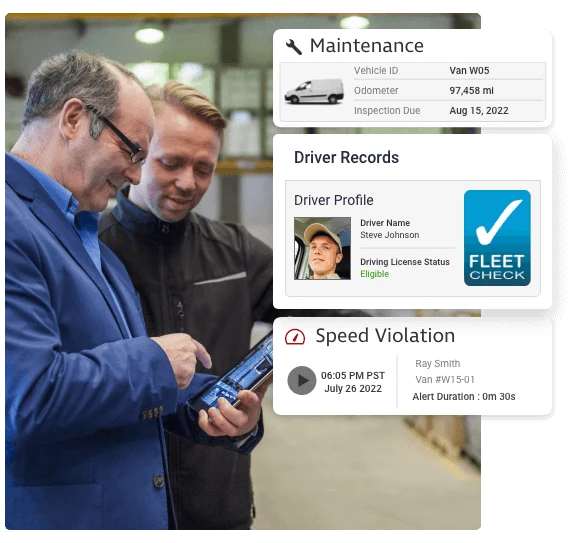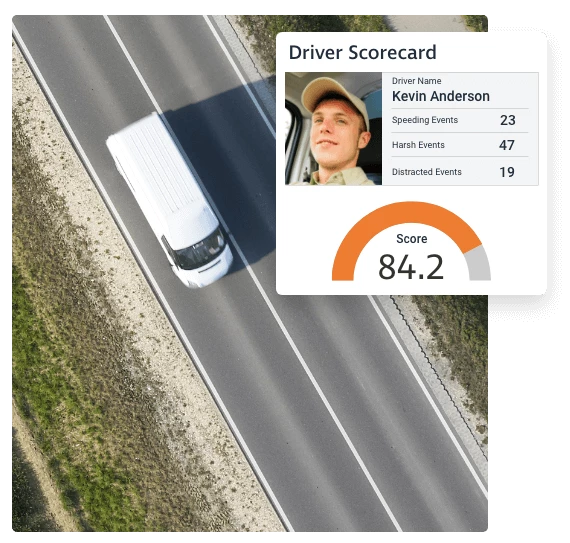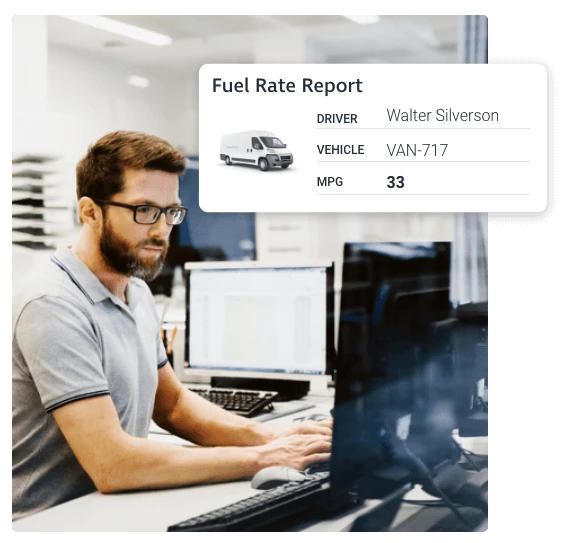

GPS van tracking is a type of software installed in transport businesses to maximise fleet visibility for owners and/or managers. It provides critical insights for informed, real-time decisions that increase driver safety, reduce fuel costs, simplify maintenance planning, streamline vehicle routing and enable fleet operations to be more flexible in meeting customer needs.
Reliant on telematics technology, van tracking systems complete a range of functions by collecting vehicle location and activity data. Their are three key components of van tracking systems, these are:
1). Telematics devices that contain a GPS receiver and cellular modem. These devices capture location and vehicle usage data and transmit this to a secure cloud infrastructure.
2). Secure cloud infrastructure that captures and organises the data so it can be displayed on a software platform.
3). Software platform, that makes the data accessible through a mapping interface, dashboards and on demand reports.
Some of the more advanced van tracking systems also include a range of connected mobile applications that digitise job management, pre-trip inspections, document management and more. These mobile apps are connected to the cloud infrastructure so data captured is instantly available in the software platform.
There are many reason why businesses operating van fleets install tracking technology and these vary significantly based on the activities the vehicles are used for and the objectives of the business. At the topline there are three areas of a business where van tracking can have a positive impact, these are:
Operational efficiency - all businesses are looking to implement effective ways to serve there customers in a sustainable way. Van tracking can help by providing visibility into the efficiency of field operations, by enabling digital transformation across key business processes, including job management and customer communication, and supporting electric vehicle transitions.
Driver safety - with in-built digital maintenance scheduling and the ability to monitor driver behaviour, van tracking systems provide the tools to create a culture of safety within your organisation. The availability of Smart Dashcams and driver coaching applications further promote self improvement and highlight safety as a responsibility of all team members.
Fleet compliance - a fleet touches many aspects of a business and operators need to consider compliance requirements for license checks, duty of care and tax. A van tracking system can help by digitising record keeping, ensuring vehicle inspections are completed and acted on, and that personal use is accounted for through benefit in kind taxation.

The latest van tracking software provides a wide range of features that enable businesses to operate their fleet more efficiently, safely and cost effectively. Here are the 5 features most used by van fleet operators:
1). Vehicle location and movement tracking. When combined with calendar templates and geofences knowing the location of vehicles and when they move can help fleet managers stay on top of unauthorised vehicle use, ensure that vehicles aren't entering locations they shouldn't and monitor time on customer sites for invoicing.
2). Job management and proof of service. The latest van tracking platforms include job management applications that digitise the process of creating and assigning jobs. These tools allow users to create daily work sheets or assign one off tasks, and track progress through to completion, including signature and photo capture.
3). Nearest vehicle search. For responsive fleets time is critical and being able to instantly identify the nearest available vehicle to a situation is key. Van tracking systems allow operations teams to instantly access this information, helping them to meet response time service level agreements.
4). Driver performance scorecards. Simple and shareable scorecards enable fleet managers to reduce fuel spend, maintenance costs and driver risk. By combining aggressive driving events, engine idling and speeding data, driver scorecards are an effective way to keep your team focused on driving safely and efficiently.
5). Exception alerts and reports. Knowing when an activity is not happening as planed and when an urgent issue is raised is a great way to identify gaps in processes and keep your fleet running smoothly. Key examples include receiving weekly reports of vehicles that were used outside of set working times, getting alerts for excessive time on a customer site or notifications when a vehicle defect is found on a pre-trip inspection.

Business who implement van tracking systems gain many benefits from the increased visibility and data the technology provides. The 5 key benefits that our customer report are:
1). Driver safety. The number one benefit* highlighted in TS23: the telematics survey, and a primary focus of fleet operators, driver safety is always top of mind. With driver behaviour monitoring, digital coaching aids and automated incentive programs van tracking technology is providing businesses with the tools to build effective safety programs.
2). Reduce fuel spend. Fleet operations report that fuel spend is their second largest expense* and van tracking systems offer many features to help businesses reduce this cost. Eliminating unauthorised use, improving driver behaviour, routing the nearest vehicle to jobs and keeping vehicles properly maintained can all be achieved with the help of van tracking software.
3). Improve customer service. In a competitive environment it is important that the service you provide differentiates your offering from the competition. By using van tracking to digitize processes, you can stand out by providing quicker response times, better communication and transparent billing process. The technology also demonstrates your commitment to duty of care and reducing environmental impact, which are important factors when bidding for new contracts.
4). Complete more jobs everyday. By having complete visibility into field activity, tools to improve job assignment and digital process that streamline administrative tasks, you can fit more jobs into each day and keep your team focused on delivering an exceptional service.
5). Reduce operational cost. In addition to fuel spend van tracking can help businesses manage the other big three operational costs of payroll, vehicle purchase and maintenance*. With digital processes optimizing workflows, effective maintenance scheduling cutting unplanned vehicle downtime and driver behaviour improvements extending vehicle life, van tracking can help your business stay operationally lean.
*TS23: the telematics survey by Teletrac Navman.

When implementing a van tracking system there are four key steps to take to ensure that the technology is helping you achieve your goals. The four key steps are:
1). Understand you needs and set goals. The first step is to engage with internal stakeholders to identify key areas of improvement and to outline objectives. Once you have clear objectives in mind you can effectively identify the right technology and solution partner.
2). Communicate and gain buy-in. It is important that all impacted parties are aware of the new technology being implemented, the reasons behind it and how the change will positively impact business performance. Transparency is key to gain buy-in.
3). Transparent measurement. To keep your team focused and to sustain improvement we always encourage businesses to share results and improvements. When a team sees the positive impact being made and the actions being taken to continue to improve it creates a shared sense of responsibility.
4). Take action. Ensure that you are using the information being gathered to make changes and drive improvement. Sharing action plans alongside results demonstrates leadership commitment to achieve the business objectives.
At Teletrac Navman we have a listen first approach and aim to build a van tracking solution designed to meet your goals. With leading technology and an experienced support team, we are ready to help you achieve even more success. Take take to first step and build your customer solution online.
There are three main types of vehicle tracking devices, professionally installed (hard-wired), self-installed (plug into a vehicles UBD port) and mobile applications. Each one of these vehicle tracking devices has their own pros and cons. Which one is right for your business depends on several factors, including cost, what data you wish to collect, and whether you want to track more than just vehicles.
Technically GPS van tracking devices can be installed almost anywhere on a vehicle. Normally OBD ports are used to run diagnostic reports and connect with the vehicle’s onboard computer. These ports can also be used to give drivers real-time data on vehicle performance such as fuel efficiency, temperature, airflow, speed and more.
The price of van tracking depends on the type of solution you need. The key is to establish your objectives for installing the technology and source a solution that will enable you to meet these goals.
The technology is designed to provide business with a strong ROI, which is strengthened when their is a strong alignment between business objectives and the solution deployed.
Yes. Van tracking systems can include driver ID solutions, where a driver identifies themselves either by key fob, keypad or ID card prior to starting there journey. This enables the data captured to be assigned to a specific driver when they use multiple vehicles.
The software offers both vehicle and driver based reporting so you can track all KPI's against vehicles or drivers.
Yes. Van tracking systems enable drivers to select whether a trip is personal or for business. When set to personal mode the technology hides location information and only records vehicle mileage. This functionality is helpful for fuel expense reporting and for benefit in kind taxation.
GPS van tracking technology is able to pinpoint the location of a vehicle or asset within six feet.
Your driver and vehicles operating van tracking will collect data such as location tracking, ignition cycles, harsh braking, harsh acceleration and speeding, number of jobs dispatched, proof-of-delivery, maintenance requirements and more.
Collecting the data provides better insight to driver safety, fuel costs, schedule maintenance, routing and customer requests and productivity.
Yes, you can use fleet management software to track the cost of maintenance across your business. Measuring items, such as repair turnover rate, can help you adhere to your preventative maintenance schedule and prevent unexpected downtime. It can also help you identify the ideal schedule for vehicle maintenance and replacement as well.